Orion Johnson - 60 years after Nagasaki
Johnson, who has spent nearly all his life, aside from his World War II service, farming in Union Grove Township, recalled seeing the effects of the heat and destructive power of the atomic bomb dropped on Nagasaki. At a hospital, he saw a medicine bottle melted to be no thicker than paper. Steel buildings had melted with their rafters bent to the ground. Japanese survivors frequently had bad sores.
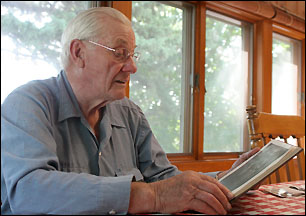 The valley, where the main part of the city was located, was demolished, said Johnson, adding that the devastation decreased as you went farther from impact point. Some ridges protected structures on the lee side. And by the time you got to the hills surrounding Nagasaki, most things were okay.
The valley, where the main part of the city was located, was demolished, said Johnson, adding that the devastation decreased as you went farther from impact point. Some ridges protected structures on the lee side. And by the time you got to the hills surrounding Nagasaki, most things were okay.
Local farmer Orion Johnson recalls his World War II memories while reading a copy of The Log, a history of the 43rd Construction Battalion.
"The odor, the smell wasn't the most fragrant odor," recalled Johnson. After seven to ten days, the smell disappeared, he added. "Either that, or we got used to it."
Johnson was a member of the 43rd Construction Battalion, known as Seabees, which landed in Nagasaki on Sept. 24, 1945, according to The Log, a history of the battalion during World War II. "The land-locked harbor was swarming with ships flying the Stars and Stripes; Jap ferry boats, crammed with curious, amazed civilians, chugged across the harbor. Masts of sunken vessels broke the surface of the water," states The Log. "Along the shore were stark reminders of visits of our air force before the war's end. Huge factory buildings lay in ruins, their frameworks left standing among the rubble. Only the quaint little ramshackle houses, grey from lack of paint, looked unharmed in their precarious perches on the hillsides."
Johnson spent nine months in Nagasaki, from September 1945 to May 1946. A heavy equipment operator - he estimated spending 90 percent of his time running heavy equipment, mainly an excavator, which they called a shovel or a crane - they started by pushing the ashes into piles and loading debris (concrete pillars, steel beams, remnants of vehicles) to haul to a dump.
The devastation of Nagasaki can be seen in pictures, said Johnson. The central city was demolished and covered with rubble. "That's the way it looked," he said. "The only things that (were left) were chimneys (and) concrete."
Later, the 43rd Construction Battalion helped rebuild the infrastructure - roads, etc. - in Nagasaki. Over time, more and more people came back to Nagasaki, Johnson said. "When I left, they were building homes for the Japanese to live. First we made a mess, then we cleaned it up," he added.
The 43rd Construction Battalion was actually scheduled to support the invasion of Kyushu, the southernmost of the main four islands of Japan. According to The Log, the battalion was formed in November 1942 in Rhode Island, had spent a year in Alaska and another year in Hawaii, and landed in Saipan in August 1945.
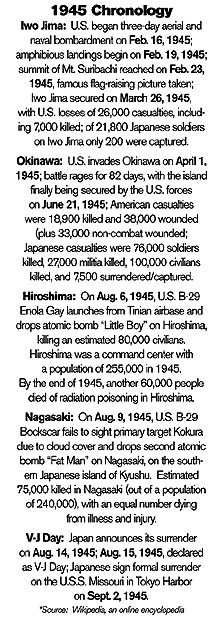
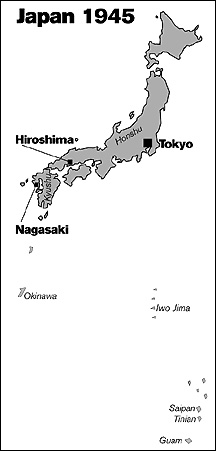 "Just before we landed at Saipan, the Japs had surrendered that island," said Johnson, who joined the battalion in Saipan. "They were still taking prisoners on that island, but the fighting was over. I imagine they didn't know the war was over."
"Just before we landed at Saipan, the Japs had surrendered that island," said Johnson, who joined the battalion in Saipan. "They were still taking prisoners on that island, but the fighting was over. I imagine they didn't know the war was over."
"Upon arrival at Saipan, we began to prepare for our part of the 'invasion' of the Japanese homeland as a shore party with the Second Marine Division for the occupation of Nagasaki," states The Log. "During our brief stay at this mudhole of the Marianas, we were equipped for a full-scale invasion and lectured on the Japanese language."
Instead, after the dropping of the atomic bombs on Hiroshima and Nagasaki in August 1945 and the subsequent surrender of Japan, the 43rd Construction Battalion went to Nagasaki in September 1945 as part of the American occupation force.
While the necessity of the use of the atomic bombs against Japan remains a historical controversy, Johnson is sure that President Harry Truman made the right decision. Upon arriving in Nagasaki aboard a 21-ship convoy, Johnson explained, "When we saw those mountains around the city, there were caves and tunnels throughout those mountains. We'd have never come home if they hadn't dropped the atomic bomb. Everybody was pretty impressed with Truman for doing what he did."
Atomic Bombs
According to Wikipedia, an online encyclopedia, Hiroshima, on Honshu, the main island of Japan, was the headquarters of Japanese Fifth Division and the field marshal commanding the defense of southern Japan. "Hiroshima was a major supply and logistics base for the Japanese military. The city was a communications center, a storage point, and an assembly area for troops," states Wikipedia. "It was chosen as a target because it had not suffered damage from previous bombing raids, allowing an ideal environment to measure the damage caused by the atomic bomb."
The city had a population of 255,000 registered for food rations in 1945.
On Aug. 6, 1945, the B-29 Enola Gay lauched from an airbase on Tinian, next to Saipan in the Marianas Islands. After a six-hour flight to Japan, it dropped an atomic bomb, named "Little Boy," with a 60-kilogram core of uranium-235.
Japanese radar detected planes and issued an alert around 8 a.m., but the alert was cancelled due to only three planes being spotted. (Along with the Enola Gay were a recording and surveying aircraft and a photographic plane.) The raid was thought to be reconnaissance.
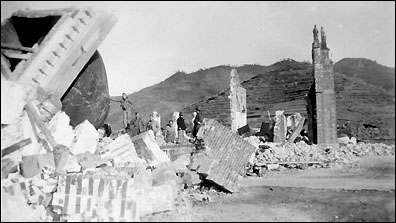 The bomb was dropped at 8:15 a.m., exploded 2,000 feet above the city with a blast equivalent to 13 kilotons of TNT, and killed an estimated 80,000 civilians with radiation poisoning killing another 60,000 by the end of 1945.
The bomb was dropped at 8:15 a.m., exploded 2,000 feet above the city with a blast equivalent to 13 kilotons of TNT, and killed an estimated 80,000 civilians with radiation poisoning killing another 60,000 by the end of 1945.
The atomic bomb melted glass and steel and left only concrete chimneys standing in the main blast area.
Nagasaki, a large sea port and center for the production of ordnance, ships, and military equipment, had never been subjected to large-scale bombing, except once in early August 1945, according to Wikipedia. As a result of that bombing, many school children were evacuated from the city.
On Aug. 9, 1945, the B-29 Superfortress "Bockscar," carrying "Fat Man," found their primary target, Kokura, obscured by clouds. After three unsuccessful runs over the city, they headed towards their secondary target, Nagasaki. The air raid signal was sounded around 7:50 a.m. in Nagasaki, but the "all clear" given at 8:30 a.m. Only two planes were sighted just before 11 a.m., and again it was assumed to be a reconnaissance mission.
At 11:02 a.m., a last-minute break in clouds over Nagasaki allowed the bombadier to visually sight target (as required). The bomb, with a core of eight kilogram of plutonim-239, was dropped over city's industrial valley and exploded at 1,540 feet, midway between Mitsubishi Steel and Arms Works in south and Mitsubishi-Urakami Ordnance Works in north, the two principal targets.
The atomic bomb killed an estimated 75,000 out of a population of 240,000 in Nagasaki, with "at least as many from resulting sickness and injury," according to Wikipedia.
Life in Japan
Ironically, the 43rd Construction Battalion bivouacked at the Mitsubishi ship yards, the primary target of the atomic bomb. "We were quartered in a large, three-story factory building, comparatively undamaged except for sections of the roof ripped away by concussion," according to The Log.
The roof still leaked, Johnson said, but not as much as no ceiling. "If you were lucky enough to get under a piece of tin, your bedding didn't get wet," he explained. The building also had a cement floor, which meant no mud, he added.
Johnson, born on a farm in Paynesville Township in 1923, moved with his family to Union Grove Township at age four. His father, Oluf, had been aboard a troop ship on the way to France in World War I when the ship was hit by a torpedo. His brother Clifford was an MP in the army in World War II, and his brother Raymond was a mechanic in air force.
The local draft board left one son (Orion) on the farm to work, but he was lonesome without his friends. "They took all the neighbor boys and left me home alone, so I went to the draft board and said, 'I don't want any more deferments.' They said, 'Are you volunteering?' And I said, 'Whatever you want to call it.' "
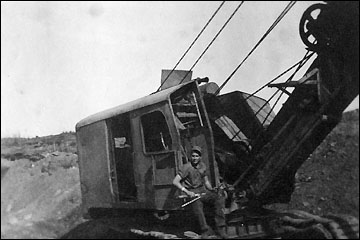 "We love our country," added Orion. "I felt I should do my part."
"We love our country," added Orion. "I felt I should do my part."
Orion Johnson operated heavy equipment for 90 percent of his time in Nagasaki, including this excavator, which they called a shovel or crane.
Orion enlisted in March 1945. While enrolling at Ft. Snelling, Orion wanted to be in the navy or marines, since his dad and brothers represented the other branches of the armed forces. "When no one was looking, I stepped over into the navy line," said Johnson. The guy at the desk did see him, but allowed him to remain when he explained.
Johnson trained at the Great Lakes Naval Base, arrived in San Francisco in July 1945 (where he met his brothers), and was shipped to Saipan in August 1945. "I was in Saipan when they dropped the atomic bomb," he said.
While some men in his unit disliked the Japanese, Johnson said he found the people to be very nice and he never had any hard feelings towards them. Johnson was invited into Japanese homes for meals, requiring him to take off his shoes and to sit on the floor, he recalled.
He said he used to know quite a few Japanese words but has forgotten most of them now.
"I had a lot of fun over there with the people, with the guys," he said.
He did have a chance to tour Kyushu some with a jeep later during his deployment. Kyushu is a "beautiful island," he said, "except where the bomb was dropped. That was a mess."
Johnson did not have a camera, but he did get some photos from his friends in the unit.
He served in Nagasaki for ten months before being discharged in 1946. There were 21 Johnsons in the 43rd Construction Battalion, so they were all known by their initials. Orion was called O.T.
A highlight for Johnson while serving in Japan was getting a letter from Wava, whom he had dated for a year before breaking up. When he got that letter, he said, "I thought people could hear me scream all the way from Japan."
Orion and Wava were married September 1946, Orion helped his dad on the farm in 1946, and he bought farmland from his dad in 1947. Now, three generations of Johnsons - Orion, his son Oluf, and his grandson Clifford - farm a couple thousand acres.
Orion has one friend from the Seabees still living, while most of the others died from cancer, he said. They were told they might be sterile but were not told why, not told about radiation, he said. Orion, who has three children with Wava, has regular physicals twice a year through the Veterans Administration, is healthy, he said, with only a little arthritis and no cancer.
Orion and Wava Johnson will celebrate their 59th wedding anniversary this year, 60 years after Orion landed in Nagasaki in the wake of the dropping of the atomic bomb in 1945.
Contact the author at editor@paynesvillepress.com • Return to News Menu
Home | Marketplace | Community